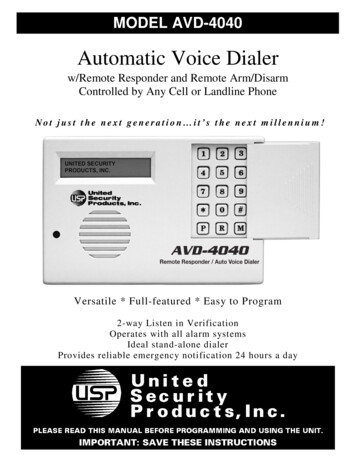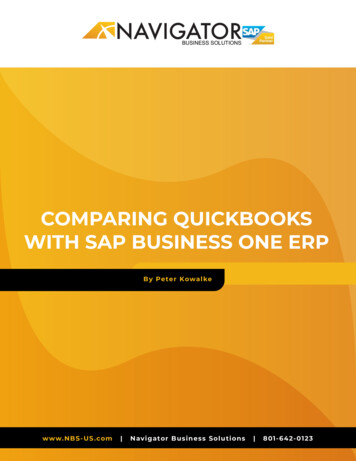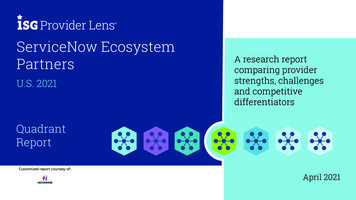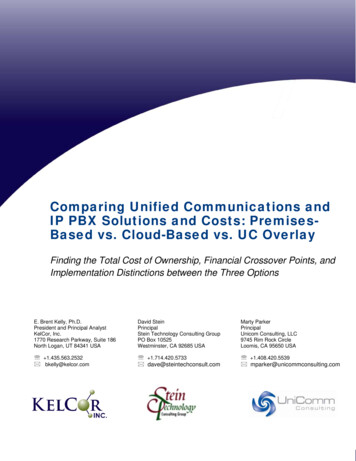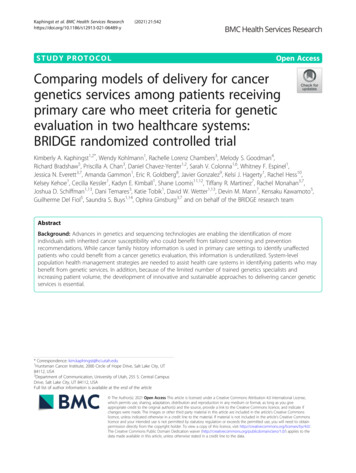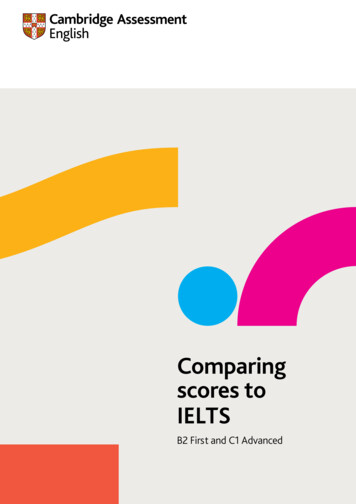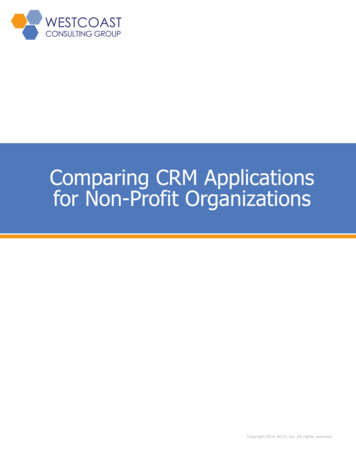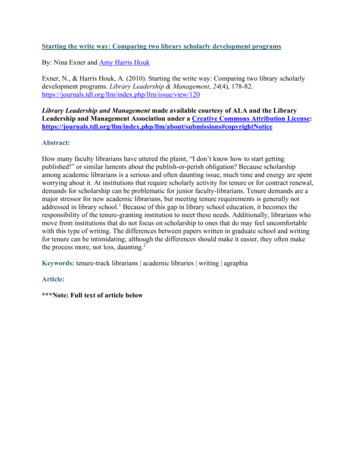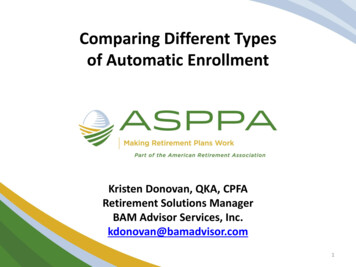
Transcription
Comparing Different Typesof Automatic EnrollmentKristen Donovan, QKA, CPFARetirement Solutions ManagerBAM Advisor Services, Inc.kdonovan@bamadvisor.com1
Agenda Introduction History of Auto-Enrollment Types of Automatic Enrollment Re-enrollment and Auto-Escalation Trends and Best Practices Wrap Up Q&A2
Introduction – Start at the Beginning Industry shifted from Defined Benefit Plans to DefinedContribution Plans Onus on participants to figure out how much to save and howto invest – can’t simply rely on social security Participants not saving enough3
Education Isn’t Always Enough4
The Problem 68 percent of participants not at target savings rate 70 percent of participants are not confident about whichinvestments to chooseJP Morgan 2016 Defined Contribution Plan Participant Survey5
Human BehaviorOrgan donation – presumed consent6
Human Behavior7
Behavioral Finance8
Auto Enrollment – The Answer?EBRI Study ResultsVoluntary Enrollment for lowest quartile earners 0.08 x final earnings at 65 Auto Enrollment4.96 or 5.33 x final earnings at 659
The Benefits Increased participation which, in turn, can help testing Help participants accumulate funds for retirement It is easy for the participants QDIA May help attract and retain employees May provide tax advantages10
AE Is Not For Everyone Employer does not want to seem paternalistic or appear totake advantage of inertia May create many small account balances Default rate probably not enough Added administrative burden and risk– Payroll must remember to start deductions on time– Correction for missed deferrals may be a corrective QNEC11
Participants Want HelpApproximately two-thirds of non-saving workers say theywould be likely to save for retirement if automatic paycheckdeductions, at either three percent or six percent of salary,were used by their employer. **The 2017 Retirement Confidence SurveyMarch 2017 EBRI Issue Brief #43112
Poll Question #1Which companies might most benefit from AE?A. Small company with low turnover, payroll person unreliableB. Medium-sized company with field workers who aren’t goodat remembering to enrollC. Organized plan sponsor with failed ADP test and employeeswho forget to sign upD. Employer who believes choice is more important thanretirement readiness13
AnswerWhich companies might most benefit from AE?A. Small company with low turnover, payrollperson unreliableB. Medium sized company with field workerswho aren’t good at remembering to enrollC. Organized plan sponsor with failed ADP testand employees who forget to sign upD. Employer who believes choice is more important thanretirement readiness14
Start at the BeginningJune 22, 1998 IRS issued Revenue Ruling 98-30– Describes circumstances in which automatic contributionsmade on behalf of employees would be treated as“elective” deferrals– Helps employees save and (bonus!) typically increases theaverage deferral percentage of the NHCEs15
Revenue Ruling 98-30 Employer to decide percentage to be contributed Employer to decide how contributions will be invested Employer to give adequate notice and information toemployees so they know how to opt out if desired– Notice upon becoming eligible and then annually16
Revenue Ruling 98-30 Department of Labor takes position that participant did notexercise control over his/her assets No fiduciary protection under ERISA section 404(c) State laws in existence that would “directly or indirectlyprohibit or restrict” auto enrollment17
Poll Question #2Which company was the first to put automatic enrollment intoeffect?A. IBMB. Exxon MobileC. McDonaldsD. General Motors18
AnswerMcDonald's Corporation became thefirst company to implement automaticenrollment when it started its401(k) plan in 198419
Pension Protection Act of 200620
Pension Protection Act of 2006 Establishes QDIA safe harbor Preempts any state law that would restrict an automaticenrollment arrangement Allows for participant withdrawals21
PPA Incentives Six months to correct failed ADP/ACP tests by distribution Safe harbor design – deemed pass of ADP test22
QDIA Safe Harbor Qualified Default Investment Alternatives must:– Not restrict participants from transferring to otherinvestment choices or impose financial penalties– Not directly invest in employer stock– Be a registered mutual fund or managed by aninvestment manager– Be diversified to minimize the risk of large losses23
QDIA Safe Harbor Qualified Default Investment Alternatives must:– Be a life-cycle, target date, or similar product or portfoliothat adjusts asset allocation and risk levels over time as aparticipant ages; or– Be a balanced fund or similar product or portfolio thatallocates assets to meet a “target level of risk appropriate forparticipants of the plan as a whole”; or– Be a managed account that adjusts asset allocations and risklevels over time to reflect the participant’s age, targetretirement date, or life expectancy24
Additional Safe Harbor Conditions Protection is only available if the following are met: Automatic enrollees must have had the opportunity to directtheir investments, but did not Automatic enrollees must have been provided with SPD,SMM, or other notice meeting specific content requirements At least 30 days prior to eligibility/initial investment At least 30 days prior to each subsequent plan year25
Additional Safe Harbor Conditions (Continued) Protection is only available if the following are met (continued):– Any plan material related to the investment in the QDIAmust be provided to the automatic enrollee– Automated enrollee must be given opportunity to moveassets from QDIA to other investment alternatives withoutpaying a penalty and at least quarterly26
Additional Safe Harbor Conditions (Continued) Protection is only available if the following are met (continued):– Plan must offer a “broad range of investment alternatives,”as defined in ERISA § 404(c) regulations at DOL Regulation§ 2550.404c-1(b)(3) At least three choices Each is diversified with materially differentrisk/return characteristics27
Types of Auto Enrollment Basic Automatic Contribution Arrangement EACA – Eligible Automatic Enrollment Arrangement QACA – Qualified Automatic Enrollment Arrangement28
Basic ACA Must state that employees will be automatically enrolled inthe plan unless they elect otherwise Must specify the percentage of an employee’s wages that willbe automatically deducted from each paycheck Must explain that employees have the right to elect not toparticipate or to elect a different percentage to be withheldUS Department of Labor – Automatic Enrollment 401(k) Plans29
Basic ACA (Continued) Employers to decide on the business’ contribution toparticipants, if any, in addition to employee salary deductions If the plan sponsor decides to make contributions:o Employers can match the amount their employees decideto contribute (within the limits of the law) oro They can contribute a percentage of each employee’scompensation (non-elective contribution) oro They can do botho They can do neither Employer has the flexibility of changing the amount each year,according to business conditions.30
EACA Uniform automatic deferral percentage Specific notice requirements May follow QDIA rules if desired Can allow automatically enrolled participantsto withdraw their contributions, with earnings,within 30 to 90 days of the first contribution (optional)US Department of Labor – Automatic Enrollment 401(k) Plans31
Withdrawals Any employee in the EACA can request a distribution of theirdefault deferrals with similar timing as other plan withdrawals– Remove all default deferrals up to request date (norestrictions)– Must adjust for earnings Deadline 90 days after first default deferral or less if chosen Can charge standard fee (or less) No spousal consent needed Taxed in year of distribution (pre-tax contributions) Applicable matching contributions forfeited or not made Amounts not counted in 402(g) limit or ADP/ACP tests32
EACA Notice Requirements Content similar to traditional safe harbor notice Default deferral rate stated Employee right to choose different rate or dollar amount How deferrals will be invested if not elected by employee If allowed, permissible withdrawal rights and procedures Must be understandable and complete Must go to all participants in EACA with time to opt out33
EACA – Special Features Does not have to include everyone eligible– All new employees– Employees in a specific division(s)– If not included, no notice requirement, no withdrawals If default deferral percentage is applied uniformly to alleligible, deadline for corrective refunds without ten percentpenalty is extended to six months34
QACASafe Harbor meets auto-enrollmentA qualified automatic contribution arrangement (QACA) is a typeof automatic enrollment 401(k) plan that automatically passescertain kinds of annual required testing. The plan must includecertain features, such as a fixed schedule of automatic employeecontributions, employer contributions, a special vestingschedule, and specific notice requirements.US Department of Labor – Automatic Enrollment 401(k) Plans35
QACA (Continued) With a QACA, the initial automatic employee contributionmust be at least three percent of the employee’scompensation. Contributions must automatically increase one percent peryear so that, by the fourth year, the automatic employeecontribution is six percent of compensation. The automatic employee contributions cannot exceed tenpercent of compensation in any year. The employee is permitted to change the amount of his or heremployee contributions or choose not to contribute, but mustdo so by making an affirmative election.36
Poll Question #3If a rehired employee has had no QACA deferrals for a full year,the plan may start him/her over again at the three percent initialrate. How is “full year” defined?A. 12 consecutive monthsB. Entire plan yearC. A period with 1,000 hours of serviceD. None of these above37
AnswerA. 12 consecutive monthsB. Entire plan yearC. A period with 1,000 hours of serviceD. None of these above38
QACA Employer ContributionEmployer must make at least either:1. A matching contribution of 100 percent for salary deferralsup to one percent of compensation and a 50 percent matchfor all salary deferrals above one percent but no more thansix percent of compensation; or2. A nonelective contribution of three percent of compensationto all participants.39
QACA Employer Contribution ExampleCost for employee earning 50,000 per year:Three percent non-elective 1,500 orDeferralrateamount1% 5002% 1,0003% 1,5004% 2,0005% 2,5006% 3,000QACA Matchrateamount1.0% 5001.5% 7502.0% 1,0002.5% 1,2503.0% 1,5003.5% 1,750Safe Harborrateamount1.0% 5002.0% 1,0003.0% 1,5003.5% 1,7504.0% 2,0004.0% 2,00040
QACA (Continued) In a QACA, you may make additional contributions toemployees’ accounts You have the flexibility of changing the amounts of theseadditional contributions each year, according to businessconditions41
Growth of Automatic Saving Features Adoption of auto enrollment has grown by 300 percent since2007 More than 60 percent of all contributing participants in 2016were in plans with auto enrollment Approximately one-third of contributing participants in 2016were auto enrolledHow America Saves 2017 - Vanguard42
Re-Enrollment Plans can provide for an expiration of elections each year May apply expiration only to those who have not made anaffirmative election or whose election is before the default If no election is made, then default deferrals begin43
Auto Escalation44
Auto Escalation A popular provision evenwithout ACA Applied to employees who haveelected it or In a QACA, applied untilparticipant reaches at least sixpercent but no more than tenpercent45
Trends and Best Practices Ensure clear, understandable communication Higher initial defaults and higher escalation amounts Escalation on enrollment form or website Embrace re-enrollment for those deferring less than the default46
Avoid Pitfalls with Smart Design Rethink immediate entry for deferrals– Maybe 30 days? If withdrawals are allowed, consider shortening window sothey don’t cross with ADP testing47
Weigh the Pros Versus the ConsPROS Increase participation Improvenondiscrimination testingresults Help participantsaccumulate meaningfulretirement savings Tax advantagesCONS Administrative issuesPaternalismCostCorrecting mistakesPerceived risk48
Temporary Rule for Corrections Typically have three months to correct before QNEC Between three months and two years QNEC 25 percent ofmissed deferrals plus any missed match Two plus years QNEC 50 percent In effect until 2020 - IRS will review to see if this ruleencourages more employers to utilize ACAs Corrective QNEC not required if error fixed within 9½ months Must still make up match in all cases49
Which Plans Would Benefit?Employers who are ready and willing to undertakeresponsibilities in exchange for the benefits for theiremployees and possibly their testing results50
This Matters Because People Matter51
Questions?
2018 ASPPATax Virtual ConferenceFriday, February 210:00 am to 2:50 pmThree Sessions Including:Pass-Through CalculationsRetirement Plan Threats and OpportunitiesAsk the Experts PanelVisit: www.asppavirtualconference.org
A. IBM B. Exxon Mobile C. McDonalds D. General Motors 18. Answer McDonald's Corporation became the first company to implement automatic enrollment when it started its 401(k) plan in 1984 19. Pension Protection Act of 2006 20. . –Any pla

